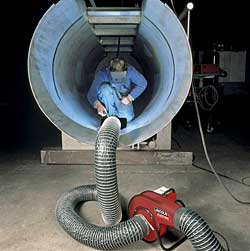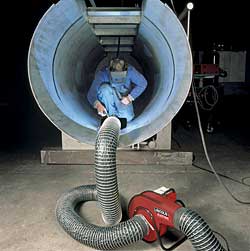
Complying with OSHA's Hexavalent Chromium Standards
The primary route of exposure is direct inhalation of the welding fume. Secondary routes of exposure could occur through surface contamination and poor hygiene.
- By Christopher J. Cole, MS, CIH, CSP
- Mar 01, 2007
 EMPLOYERS are under continuous pressure to improve quality, increase productivity, provide a safe work environment, and control costs. The key to determining the level of effort needed to comply with the new Hexavalent Chromium (Cr(VI)) Standard is to understand how OSHA has intentionally structured the standard.
EMPLOYERS are under continuous pressure to improve quality, increase productivity, provide a safe work environment, and control costs. The key to determining the level of effort needed to comply with the new Hexavalent Chromium (Cr(VI)) Standard is to understand how OSHA has intentionally structured the standard.
(This article focuses on the requirements of the Cr(VI) Standard as they apply to the welding industry. It conveys OSHA's intent based on information in the standard's preamble; refer to the standard for the full regulatory requirements.)
What You Need to Know
Does the new standard apply to my welding operations? Are you welding on stainless, alloy steel, or hardfacing alloys containing chromium? Is there any surface coating or plating that contains chromium? Do the consumables you are using contain chromium? If the answer is yes to any of these questions, then the standard applies to you.
What is the exposure of each potentially exposed worker? Before you can determine what requirements apply to you, you have to determine each employee's exposure level.
You have time to evaluate and plan the best permanent engineering controls for your operations. In the interim, you can use personal protective equipment to protect your employees until May 31, 2010.
Determine the financial burden of not being able to permanently control exposures.
Increased PPE usage, ongoing medical surveillance, and increased sampling costs are direct costs that hit you every year, whereas the cost of engineering controls can be spread out over many years.
Hazard communication and recordkeeping requirements demonstrate your compliance. Regardless of the level of requirements with which you must comply, you must perform and maintain these requirements properly.
OSHA's Hexavalent Chromium Standards
There are three standards:
- General Industry, 29 CFR 1910.1026
- Shipyards, 29 CFR 1915.1026
- Construction, 29 CFR 1926.1126
These standards are the same, with the exception that general industry has additional housekeeping and regulated area requirements.
Exposure Determination
There are two options for determining each employee's potential exposure. A performance-oriented option is based on a company's historical monitoring data or objective data, including material composition and industry-wide exposure data. A second option is based on performing scheduled monitoring, where the frequency of sampling is specified and an incentive is offered to discontinue monitoring if you demonstrate that an employee's exposure level is below the action limit.
Because each employee's exposure has to be determined, there is an incentive to group employees into "similar exposure groups," for which OSHA specifies the worst-case exposure be determined. For the construction and shipbuilding industries, a task-based exposure assessment might be used to develop exposure classes. With so many judgments and decisions based on these "numbers," it is in an employer's best interest to use a certified industrial hygienist to set up the exposure groupings and characterize the employees' exposure.
Professional industrial hygiene monitoring services may be obtained through OSHA's free state consultation service. This is an excellent service that is run by professional consultants who will work fairly with you. Alternately, some employers may have sampling provided as part of their worker's compensation premiums. Also, the American Industrial Hygiene Association maintains a consultants list for professional industrial hygiene services.
The Regulatory Triggers: Permissible Exposure & Action Limits
OSHA determined that a Cr(VI) Permissible Exposure Limit (PEL) of 5.0 µg/m3 as an 8-hour time-weighted average (TWA) could be achieved through engineering and work practice controls with <5% respirator usage.
The Action Limit (AL) is 2.5 µg/m3 as an 8-hour TWA. OSHA considers personal sample results at one half the PEL as sufficient to ensure an employee's exposure would not exceed the PEL on days not sampled. As a performance standard the PEL and AL trigger the standards' regulatory requirements. Conversely, if you control personal exposures below these triggers, then you do not incur their requirement and cost (see Table 1).
Table 1. Exposure Monitoring Triggers for: |
No initial monitoring |
= Objective or historic data < 0.5 µg/m3 |
No follow-up monitoring |
= < AL |
Monitor every six months |
= > AL < PEL |
Monitor every three months |
= > PEL |
Designated Regulated Area |
= > PEL |
Exposure controls |
= > PEL for > 30 days/year |
Regulated Area |
= > PEL |
Respirator |
= > PEL and engineering controls not available or adequate |
Medical surveillance |
= > AL for > 30 days/year |
Housekeeping, hygiene, other PPE |
= Qualitative Assessment |
PEL = 5 µg/m3 AL = 2.5 µg/m3 |
Methods of Control
For welding applications, the primary route of exposure is direct inhalation of the welding fume. Secondary routes of exposure could occur through surface contamination and poor hygiene. Evaluation of the primary route of exposure is determined by air sampling. Evaluations of the secondary routes of exposure are based upon a qualitative assessment using "reasonable" judgment.
Engineering & Work Practice Controls
OSHA requires that "Employers . . . use engineering and work practice controls as the primary means to reduce and maintain employee exposures to Cr(VI) below the PEL." (OSHA Small Entity Compliance Guide for the Hexavalent Chromium Standards, Page 9, OSHA 3320-10N 2006)
Engineering and work practice controls consist of: substitution, isolation, ventilation, and work practices. OSHA believes that 60 percent of current stainless steel SMAW operations may need to switch to gas metal arc welding (GMAW) as the "cheapest and most effective method" to reduce Cr(VI) exposures. (U.S. Department of Labor; OSHA. Occupational Exposure to Hexavalent Chromium, Final Rules, Fed. Reg. 71:10336, Feb. 28, 2006)
There are two cautions here: One is that welding fume generation is dependent upon more than the consumable used. In fact, the total impact of the welding process, consumable, amperage, shielding gas, and other advanced technology on fume generation needs to be considered. The second caution is that one engineering control may not be enough to reduce employee exposure below the PEL or below the AL. In that case, a systems approach to permanent fume control may include not only a reduction in fume generation, but also the use of ventilation and complementary work practices.
Depending upon the application, source extraction, local exhaust, and general mechanical ventilation all can provide good, permanent solutions. OSHA has determined that "local exhaust systems that capture airborne Cr(VI) near its source and remove it from the workplace . . . is generally preferred to dilution ventilation because it provides a cleaner and healthier work environment." The greatest challenge is in construction and shipbuilding, where temporary ventilation solutions involve more high vacuum/low volume type systems and require a larger degree of employee involvement to move the ventilation hood frequently. (OSHA Small Entity Compliance Guide for the Hexavalent Chromium Standards, Page 9, OSHA 3320-10N 2006)
OSHA recognized that applications such as welding need to be thoroughly investigated to determine the most feasible and practical engineering solutions and thus extended the implementation date for adopting new engineering controls until May 31, 2010. Work practices independent of engineering controls, such as keeping your head out of the fume plume, should be implemented now. There are two reasons not to put off exploring solutions: 1) It will take time to thoroughly explore all your options; 2) There are significant costs now, including hidden productivity costs, associated with not being able to permanently control exposures with engineering controls below the AL.
The Costs of Not Permanently Controlling Exposures
OSHA has determined that "If feasible engineering and work practice controls are not sufficient to reduce employee exposure to or below the PEL, the employer must use them to reduce the exposure to the lowest level achievable. Respirators must then be used to reduce employee exposure to or below the PEL." Note that respirators can be used between now and May 31, 2010, while employers are exploring engineering options. (OSHA Small Entity Compliance Guide for the Hexavalent Chromium Standards, Page 10, OSHA 3320-10N 2006)
Increased PPE costs, hygiene facilities, restricted areas, medical surveillance, ongoing monitoring costs, and all of their direct and productivity losses are incurred by not being able to utilize engineering and work practice controls to reduce exposures below the AL. While the cost of engineering controls can be spread out over years, all of the personal compliance costs hit in the current fiscal year and are incurred per worker, year after year.
Hazard Communication and Recordkeeping Requirements
Follow the requirements of the Hazard Communication Standard (29 CFR 1910.1200) and medical surveillance. Regardless of the requirements with which you must comply, you must perform and maintain these requirements properly in order to be able to demonstrate you are in compliance. If you come to OSHA's attention, most likely it will be through the filing of an employee complaint.
Conclusion
Determining the "best" welding solution for your application includes consideration of production and quality specifications; process, consumables, and procedure choices; cost constraints; welder skills; infrastructure support; as well as other factors. Inevitably, in making choices and balancing different demands, the "best" solution may not be one overarching solution, but rather, a set of overlapping or tiered solutions.
Contact your welding technical sales representative to help you in this investigation. These individuals can bring expertise and resources to assist you. Your best solution should not result in less acceptable quality, productivity, or worker protection.
This article appeared in the March 2007 issue of Occupational Health & Safety.
This article originally appeared in the March 2007 issue of Occupational Health & Safety.